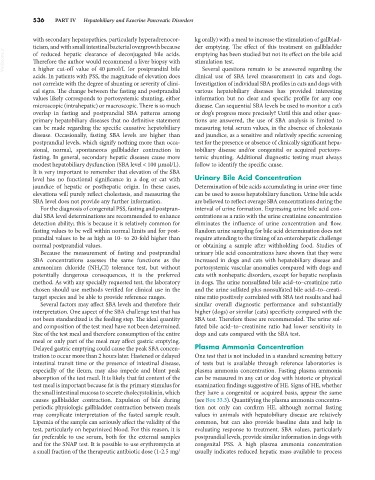Page 564 - Small Animal Internal Medicine, 6th Edition
P. 564
536 PART IV Hepatobiliary and Exocrine Pancreatic Disorders
with secondary hepatopathies, particularly hyperadrenocor- kg orally) with a meal to increase the stimulation of gallblad-
ticism, and with small intestinal bacterial overgrowth because der emptying. The effect of this treatment on gallbladder
VetBooks.ir of reduced hepatic clearance of deconjugated bile acids. emptying has been studied but not its effect on the bile acid
stimulation test.
Therefore the author would recommend a liver biopsy with
Several questions remain to be answered regarding the
a higher cut-off value of 40 µmol/L for postprandial bile
acids. In patients with PSS, the magnitude of elevation does clinical use of SBA level measurement in cats and dogs.
not correlate with the degree of shunting or severity of clini- Investigation of individual SBA profiles in cats and dogs with
cal signs. The change between the fasting and postprandial various hepatobiliary diseases has provided interesting
values likely corresponds to portosystemic shunting, either information but no clear and specific profile for any one
microscopic (intrahepatic) or macroscopic. There is so much disease. Can sequential SBA levels be used to monitor a cat’s
overlap in fasting and postprandial SBA patterns among or dog’s progress more precisely? Until this and other ques-
primary hepatobiliary diseases that no definitive statement tions are answered, the use of SBA analysis is limited to
can be made regarding the specific causative hepatobiliary measuring total serum values, in the absence of cholestasis
disease. Occasionally, fasting SBA levels are higher than and jaundice, as a sensitive and relatively specific screening
postprandial levels, which signify nothing more than occa- test for the presence or absence of clinically significant hepa-
sional, normal, spontaneous gallbladder contraction in tobiliary disease and/or congenital or acquired portosys-
fasting. In general, secondary hepatic diseases cause more temic shunting. Additional diagnostic testing must always
modest hepatobiliary dysfunction (SBA level < 100 µmol/L). follow to identify the specific cause.
It is very important to remember that elevation of the SBA
level has no functional significance in a dog or cat with Urinary Bile Acid Concentration
jaundice of hepatic or posthepatic origin. In these cases, Determination of bile acids accumulating in urine over time
elevations will purely reflect cholestasis, and measuring the can be used to assess hepatobiliary function. Urine bile acids
SBA level does not provide any further information. are believed to reflect average SBA concentrations during the
For the diagnosis of congenital PSS, fasting and postpran- interval of urine formation. Expressing urine bile acid con-
dial SBA level determinations are recommended to enhance centrations as a ratio with the urine creatinine concentration
detection ability; this is because it is relatively common for eliminates the influence of urine concentration and flow.
fasting values to be well within normal limits and for post- Random urine sampling for bile acid determination does not
prandial values to be as high as 10- to 20-fold higher than require attending to the timing of an enterohepatic challenge
normal postprandial values. or obtaining a sample after withholding food. Studies of
Because the measurement of fasting and postprandial urinary bile acid concentrations have shown that they were
SBA concentrations assesses the same functions as the increased in dogs and cats with hepatobiliary disease and
ammonium chloride (NH 4 Cl) tolerance test, but without portosystemic vascular anomalies compared with dogs and
potentially dangerous consequences, it is the preferred cats with nonhepatic disorders, except for hepatic neoplasia
method. As with any specially requested test, the laboratory in dogs. The urine nonsulfated bile acid–to–creatinine ratio
chosen should use methods verified for clinical use in the and the urine sulfated plus nonsulfated bile acid–to–creati-
target species and be able to provide reference ranges. nine ratio positively correlated with SBA test results and had
Several factors may affect SBA levels and therefore their similar overall diagnostic performance and substantially
interpretation. One aspect of the SBA challenge test that has higher (dogs) or similar (cats) specificity compared with the
not been standardized is the feeding step. The ideal quantity SBA test. Therefore these are recommended. The urine sul-
and composition of the test meal have not been determined. fated bile acid–to–creatinine ratio had lower sensitivity in
Size of the test meal and therefore consumption of the entire dogs and cats compared with the SBA test.
meal or only part of the meal may affect gastric emptying.
Delayed gastric emptying could cause the peak SBA concen- Plasma Ammonia Concentration
tration to occur more than 2 hours later. Hastened or delayed One test that is not included in a standard screening battery
intestinal transit time or the presence of intestinal disease, of tests but is available through reference laboratories is
especially of the ileum, may also impede and blunt peak plasma ammonia concentration. Fasting plasma ammonia
absorption of the test meal. It is likely that fat content of the can be measured in any cat or dog with historic or physical
test meal is important because fat is the primary stimulus for examination findings suggestive of HE. Signs of HE, whether
the small intestinal mucosa to secrete cholecystokinin, which they have a congenital or acquired basis, appear the same
causes gallbladder contraction. Expulsion of bile during (see Box 33.3). Quantifying the plasma ammonia concentra-
periodic physiologic gallbladder contraction between meals tion not only can confirm HE, although normal fasting
may complicate interpretation of the fasted sample result. values in animals with hepatobiliary disease are relatively
Lipemia of the sample can seriously affect the validity of the common, but can also provide baseline data and help in
test, particularly on heparinized blood. For this reason, it is evaluating response to treatment. SBA values, particularly
far preferable to use serum, both for the external samples postprandial levels, provide similar information in dogs with
and for the SNAP test. It is possible to use erythromycin at congenital PSS. A high plasma ammonia concentration
a small fraction of the therapeutic antibiotic dose (1-2.5 mg/ usually indicates reduced hepatic mass available to process

